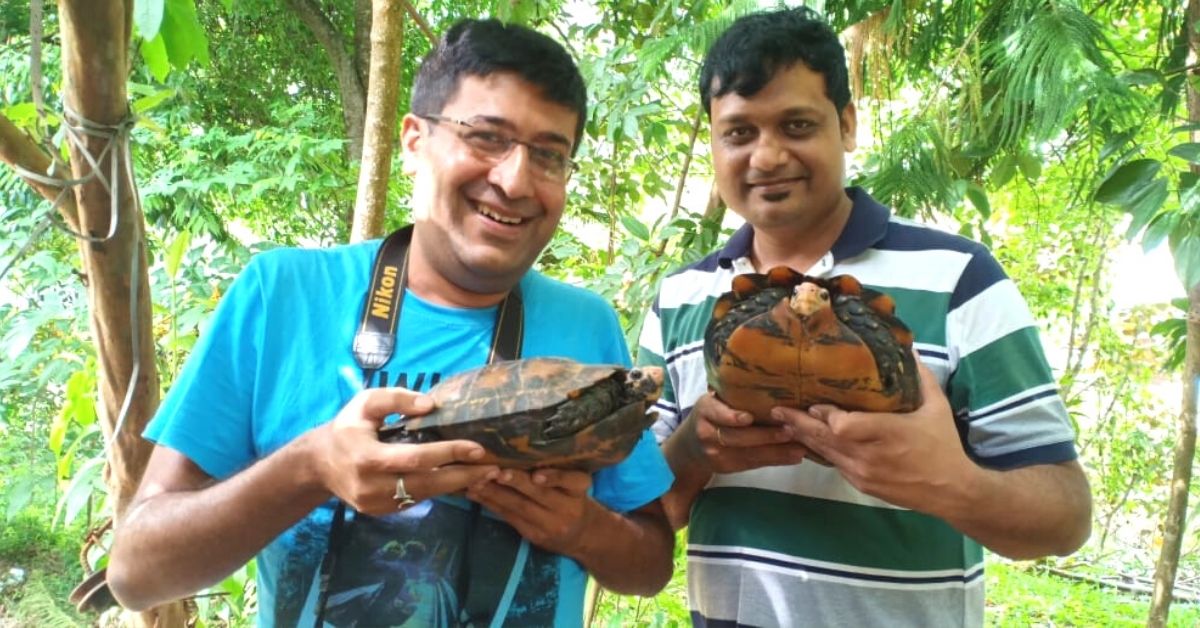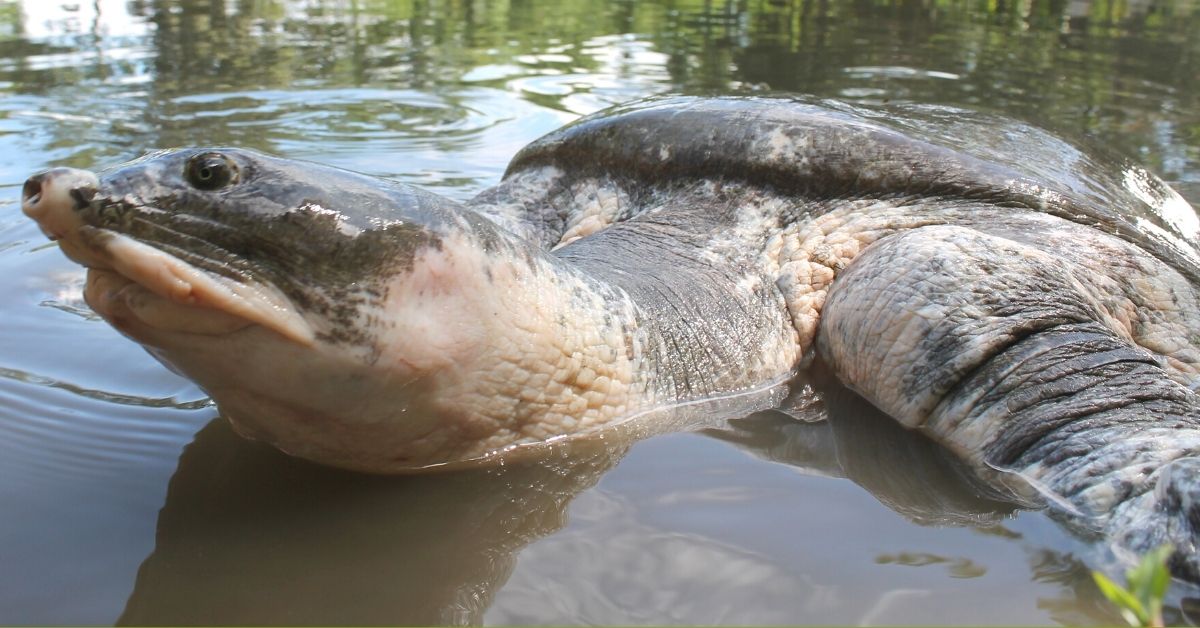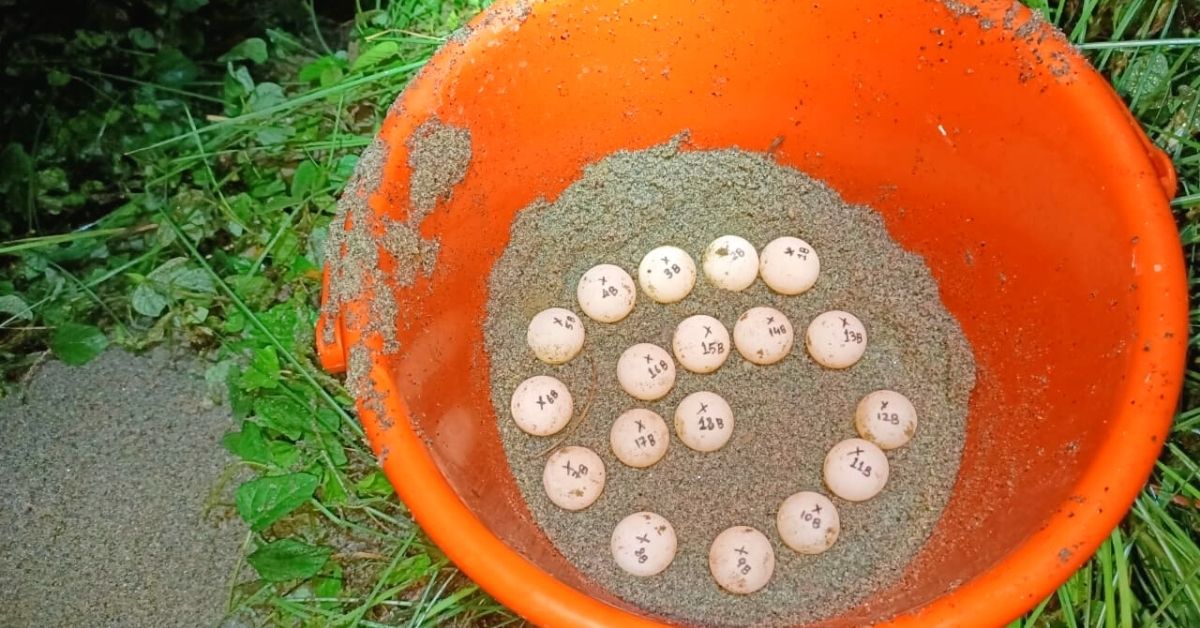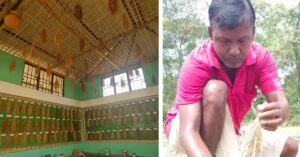Assam Man Fights Ancient Beliefs, Helps Release 300 ‘Extinct’ Turtles From Pond
Jayaditya Purkayastha from Guwahati is attempting to revive the black softshell turtles, native to the Brahmaputra River and parts of Bangladesh, by releasing the hatchlings in the Pobitora Wildlife Sanctuary. He has revived 300 such turtles so far

This article is a part of The Better India’s series to highlight the work of those who have dedicated their lives to saving some of the most endangered species of plants and animals in India. This Environment Day, join us in saluting their work.
Native to the Brahmaputra River in India and some parts of Bangladesh, black softshell turtles play a significant role in maintaining and restoring the wetland water system. On land, they improve the health of the soil through borrowing and assist the soil formation process. In water, they cleanse the river body and help the underwater ecosystem thrive.
Once found abundantly in the region, the freshwater species are now classified as extinct in the wild. This is mainly due to humans hunting the animal for meat, and religious beliefs that have confined them in the temple ponds of Assam. Though thought to be extinct in the wild, a few sightings in 2007-08 revealed a decimated population, says Shailendra Singh, director of the India programme at Turtle Survival Alliance.
In Guwahati, herpetologist Jayaditya Purkayastha is attempting to revive the species and upgrade its status to ‘critically endangered’ by reintroducing the animals in the wild. During 2016-17, he released 300 such softshell turtles into the Pobitora Wildlife Sanctuary.
His journey towards the conservation of turtles began in 2010, while he was studying reptiles and amphibians in the wild. “I remember that black softshell turtles were caught in large numbers through fishnets, and became part of the sea, river, or freshwater resources for consumption. But during research, I learned that they have become rare, or are not found in their natural habitat,” the 39-year-old says.
“Turtles do not enjoy the same privilege of having an “exotic ‘value” as tigers or rhinos. They are a neglected endangered species, and need saving,” Jayaditya emphasises, adding that when he was awarded the Mohamed Bin Zayed Species Conservation Fund in 2012, he decided to invest in reviving the wild population.
From the wilderness to confinement

Jayaditya says religious beliefs are the reason for the turtles reaching temple ponds. “The tradition links back to the Ahom kings when these turtles were deeply admired and donated to the ponds. The practise continues today — people donate the turtle when a child is born, as it represents long life, or to mark a woman’s menstruation cycle, as it symbolises fertility,” he adds. Despite its rarity, people have reared it domestically. Occasionally, a turtle would find itself stuck in the fishnet, be sold to a donor, and eventually make its way to the temple.
The researcher says that around 29 temple ponds in Assam have these turtles. The animal never returned to the wild and faced multiple threats. “The turtles did not get their natural diet and depended on bread, rice puff, biscuit, or other food items offered by visitors. A large population of the animal in small spaces led to overcrowding. The pond structure, often surrounded by stone or concrete, did not allow turtles to swim outside the water and bask in the sun. This, combined with the large population, poor food habits and lifestyle, led to the fear of diseases. One disease infestation can wipe out the entire population in the pond,” he explains.
Understanding the need to conserve and revive the wild population, Jayaditya approached temple authorities. But he was met with refusal. “Getting the turtles away from the temple premises would mean hurting religious sentiments of the devotees. I learned that some environmentalists had also tried to pursue the task, but had been unsuccessful,” Jayaditya says.
Signs of change

To help temple authorities understand the biological needs of the turtle, Jayaditya showed them the injury marks on the animal. He showed them the nails, which had broken off when the turtle would attempt to climb the tall concrete structure and out of the water. Its skin was damaged due to prolonged submergence. A few weeks later, the temple administration agreed to cooperate, and one side of the wall was removed to create a slope with some riverine sand. Slowly, the turtles started basking out in the sun.
“The visibility of the animal also created curiosity and a sense of affection among devotees. Soon, a floating bamboo structure was introduced in the pond, allowing more turtles to bask. Some turtles started laying eggs. But only 30 per cent of the eggs hatched, as the conditions were not optimum,” Jayaditya says.
He adds that the turtles found it hard to keep the eggs safely tucked inside soil, away from predators and sun. “To find a solution to this problem, a small dark room with controlled humidity was constructed on the premises. This increased the hatching to 90 per cent. From 10-14 hatchlings earlier, the number grew to hundreds,” he says. Unable to accommodate such a large number of turtles, authorities agreed to keep them outside the temple for survival,” he says.
This road to success was four years long. “In 2016, the state forest department became part of the effort, and it was agreed that the eggs would hatch in the zoo and then released in the wild. The older turtles have made the ponds their home, and lost the ability to hunt food and survive. However, the new hatchlings can still adapt and learn the art of survival,” he adds.
Jayaditya says that once the eggs hatch, the turtles are quarantined for a few days, checked for any diseases, and then released after six months. “This ensures that no potential diseases are being spread unknowingly in the wild, and also that the turtles are healthy and have fewer threats from predators,” he adds.
Temples such as Haigrib Madhab, Nagshankar, Gorokhiya Gohain Than and Ugrotara agreed for the task, and the most recent batch of turtles was released in September-October in 2019.
‘This is just the beginning’

Shailendra says, “The Nagshankar temple agreed to allow dried fish to be given to the turtles after many died in February 2020, and to restrict non-dietary food. The job of making fish balls, sold at Rs 10, is entrusted to local vendors from the same village. Change in mindset demonstrates that alternatives are acceptable for the conservation of animals through constant awareness and persistence The fish balls also became a lucrative business opportunity for locals.”
He further says that plans are underway to work closely with temple authorities, where the devotees will be offered terracotta turtles instead. The priests will perform the rituals as usual, and after the ceremony, the turtles will be put near the pond, and can be recycled. “This way, the religious sentiments are protected while ensuring the conservation,” he adds.
Jayaditya says the achievement is just the beginning of the long road that lies ahead. “We have found that there are multiple species in these temple ponds, and some are yet to be identified and conserved. The situation also opens the possibility of cross-breeding. A hybrid species in the wild may threaten the parent species. There is a need to understand if the species has undergone biological changes during long term confinement. We have to be careful of what we put back in the wild,” he cautions.
He adds that artificially hatching the eggs poses another threat. “The mother arranges the eggs in a honeycomb manner. During incubation, the temperature that the eggs are exposed to depends on their arrangement, and that determines the sex of the animal. One temperature for all may lead to the birth of same-sex turtles, which will be wrong. Hence, a safer environment is needed for them to breed and hatch through the natural process with their mother,” he says.
Need for a viable population

However, as another set of turtles awaits its release in the coming weeks, the fate of the 300 turtles released so far is unknown. “Though they were released in the buffer zone of the wildlife sanctuary, there is no mechanism to track them. There is a need to collar and geo-tag them to understand the ecological and biological behaviour for long term conservation. And all of the above require funds. It is easier to get funds sanctioned to protect an exotic animal,” Jayaditya says, adding that about 30 applications seeking funds to protect the turtles have not received any positive response.
Divisional forest officer at Assam state zoo, Tejas Mariswamy, says that it is important to protect every species in the environment conservation process. “The loss of any species is bound to have implications on the natural balance. The black softshell turtle is declared extinct in the wild, but Jayaditya’s efforts are a big step towards reintroducing them to the wild,” he says.
However, Tejas adds that consistent efforts are needed in this direction to see a significant change. “We are in the process of signing an MoU with multiple stakeholders and working towards conservation,” he adds.
How many more turtles do we need in the wild until they reach a viable population that ensures their survival? There is no fixed answer to the question, says Jayaditya. “The exact population is unknown, and more importantly, it is the breeding population of the species that matters. Just as the temple ponds face threats, the natural habitat is equally unsafe. There is heavy sand mining in Brahmaputra river, and floods, loss of habitat, pollution and poaching make their survival in the wild even more challenging,” he says.
Emphasising ensuring the survival of the species, Jayaditya cites an analogy, “The turtles are the base of the ecosystem. Imagine the consequences if the foundation of a building collapses? The turtle is an unsung hero of the environment, and the secret, an elusive animal needs protection for its survival.”
Edited by Divya Sethu
This story made me
- 97
- 121
- 89
- 167
Tell Us More
We bring stories straight from the heart of India, to inspire millions and create a wave of impact. Our positive movement is growing bigger everyday, and we would love for you to join it.
Please contribute whatever you can, every little penny helps our team in bringing you more stories that support dreams and spread hope.



















